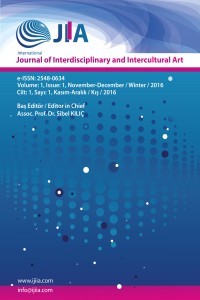MİNİMAL SANAT ve KAMUSAL ALANDA MİNİMAL HEYKEL
Minimal sanat, 1960’larda ortaya çıkmış bir akımdır. Soyut dışavurumculuğun biçime verdiği öneme
karşı bir tutum benimsemiştir. Minimal sanatın geometrik formu, kesin çizgileri, endüstriyel üretimi
ve formdaki yalınlığı en saf görünümde olma eğilimi içindedir. Kimi zaman formun yalınlığıyla rengi
birleştirir. Sanatçı kullandığı malzemenin enerjisinin dışavurumuna dikkat eder ve çalışmalarda
bütünlük algısını bozacak her tür ayrıntıyı reddeder. İzleyiciye anlatmak istediğini hikayeleştirmeden
aktarır. Akımın oluşumundan itibaren dikkatleri üzerine çekmesindeki faktörlerden biri de Rosalind
Krauss, Barbara Rose ve Michael Fried gibi döneminin en iyi sanat eleştirmenleri tarafından olumlu
veya olumsuz yönleriyle irdelenip minimalizm hakkında eleştiriler yazılmış olmasıdır. Öncü
sanatçıları Robert Morris, Donald Judd, Sol LeWitt, Dan Flavin, Larry Bell, Carl Andre ve Richard
Serra’dır. Minimal heykel izleyicisi ile etkileşimli bir ilişki kurmuş, kamusal alanda ve bulunduğu
mekânda yaşayan heykel anlayışı ile modernist sanatı reddeden formalist bir yaklaşımı
benimsemiştir. Mekânla arasında dinamik bir bağ kurarak bütünlük oluşturma düşüncesi, Robert
Morris’le hayat bulmuş ve Richard Serra ile devamlılığını sürdürmüştür. Bu çalışmada minimal
sanatın ortaya çıkışı, tarihsel gelişimi ve minimal sanat özelinde kamusal alan heykeli araştırılmıştır.
Araştırmanın zemini kamusal alanda minimal sanat uygulamalarının izleyiciyle girdiği etkileşimden
beslenip varlığını ortaya koyabilmiş olmasına dayanır. Heykelin konumlandığı mekân ile kurduğu
bağ önemli örneklerle ele alınmıştır. Maurice Merleau Ponty felsefesinde olduğu gibi izleyenin
dünyada çevresiyle sürekli ortaya çıkan bir karşılaşma içinde olduğunu ve bu karşılaşmanın da
minimal sanat bağlamında ortaya çıkışı ele alınmıştır.
Anahtar Kelimeler:
Minimal Sanat, Heykel, Kamusal Alan, Mekân, Minimal Heykel
MINIMAL ART AND MINIMAL SCULPTURE IN THE PUBLIC AREA
Minimal Art is a movement that emerged in the 1960s, which adopted an attitude that was excessively
emotional and against the importance given to form by Abstract Expressionism. The geometric form
of Minimal Art, its precise lines, industrial production and simplicity of form tend to be in its purest
appearance. Sometimes it combines the simplicity of form with color. The artist pays attention to the
expression of the energy of the material he uses and rejects any detail that would disrupt the
perception of integrity in his works. He conveys what he wants to tell the audience without telling a
story. One of the factors that attracted attention from the beginning of the movement was that the
best art critics of the period such as Rosalind Krauss, Barbara Rose and Michael Fried were
scrutinized with positive or negative aspects and critiqued about Minimalism. Leading artists are
Robert Morris, Donald Judd, Sol LeWitt, Dan Flavin, Larry Bell, Carl Andre and Richard Serra.
Minimal sculpture has established an interactive relationship with its audience, and has adopted a
formalist approach that rejects modernist art with its understanding of sculpture living in the public
space and the place where it is located. The concept of creating integrity by establishing a dynamic
connection with the space came to life with Robert Morris and continued with Richard Serra. In this
study, the emergence of Minimal Art, its historical development and public space sculpture, in
particular, were investigated. The ground of the research is based on the fact that Minimal Art
practices in the public space were able to reveal their existence by feeding from the interaction with
the audience. The bond that the sculpture establishes with the place where it is located is discussed
with important examples. As in the philosophy of Maurice Merleau Ponty, the viewer is in a
constantly emerging encounter with his environment in the world and the emergence of this
encounter in the in the context of Minimal Art is discussed.
Keywords:
Minimal Art, Sculpture, Public Space, Place, Minimal Sculpture,
___
- Artun, A. (2017). Bauhaus Modernleşmenin Tasarımı. İstanbul: İletişim Yayınları.
- Battcock, G. (1968, Aralık). Minimal Art. Ulusal Sanat Eğitimi Dergisi. Cilt. 21, No. 9, s. 7-12. 01 Mayıs 2021. https://www.jstor.org/stable/3191203
- Batur, E. (1997). Modernizmin Serüveni. İstanbul: Yapı Kredi Yayınları.
- Bektaş, D. (1997). Süprematizm ve Konstrüktivizm, Eczacıbaşı Sanat Ansiklopedisi. Cilt:2, s.705, İstanbul: Yapı-Endüstri Merkezi yayınları.
- Collins, J. (2007). SculptureToday. China: Phaidon.
- Carter, C. L. (2010). Toward an Understanding of Sculpture as Public Art. Marquette University, ePublications. https://epublications.marquette.edu/cgi/viewcontent.cgi?article=1062&context=phil_fac (Erişim Tarihi: 05.11.2021).
- Çakar, N. (2014). Kent, Kamusal Alan ve Anıt Heykel İlişkisi. Sanat Dergisi, (26), 37-54. https://dergipark.org.tr/tr/pub/ataunigsfd/issue/45081/563074
- Davis, D. (1996). “1960’ların Başında Yeni Malzemeler” Genç Sanat Güzel Sanatlar Dergisi. (F. Özgür, Çev.), (sayı:22-s.24)
- Fineberg, J. (2014). 1940’tan Günümüze Sanat. (A- Eskier- Simber&G. E. Yılmaz, Çev.). İzmir: Karakalem Kitabevi Yayınları.
- Foster, H. (2017). Gerçeğin Geri Dönüşü- Yüzyılın Sonunda Avangard. (E. Hoşsucu, Çev.). İstanbul: Ayrıntı Yayınları.
- Habermas, J. (2003). Kamusallığın Yapısal Dönüşümü. (T. Bora & M. Sancar, Çev.). İstanbul: İletişim Yayınları.
- Harrıson, C., Wood, P. (2016). Sanat ve Kuram. (S. Gürses, Çev.). İstanbul: Küre Yayınları.
- Heartney, E. (2008). Art Today. New York: Phaidon.
- Krauss. R., E. (1977). Passages in Modern Sculpture. New York: Viking.
- Kuzu, F. (2009). Türkiye’de Kamusal Alan Estetiği ve Heykel. Işık Üniversitesi Sosyal Bilimler Enstitütüsü. Yüksek Lisans Tezi.
- https://tez.yok.gov.tr/UlusalTezMerkezi/tezDetay.jsp?id=f0YmaOvUbaag0Rbnj8Nyw&no=Mah53C36q-6TfzeM5LqH Meyer, J. (1964-69). Minimalizm. New York: Phaidon.
- Morris, R. (1966). Notes on Sculpture. Part 2, s.232. 04 Haziran 2021 https://arts.berkeley.edu/wp-content/uploads/2016/01/robert-morris-notes.pdf
- Phillips, S. (2016). İzmler Modern Sanatı Anlamak. (D. N. Özer, Çev.). İstanbul: Yapı-Endüstri Merkezi Yayınları.
- Ponty, M., M. (2006). Göz ve Tin. (A. Soysal Çev.). İstanbul: Metis Yayınları.
- Ruhberg, K. VeSchneckenburger, M. VeFrickle, C. VeHonnef, K. (2000). Art of the 20th Centruy. Spain: Taschen.
- The Art Story. (t.y.) Important Minimalist Sculpters. https://www.theartstory.org/movement/minimalism/artworks/ (Erişim tarihi: 18.03.2021).
- Şahan, M. (2016). Kentsel Alanda Heykel ve Çevre İlişkisi Üzerine bir inceleme. Anadolu Üniversitesi Sanat ve Tasarım Dergisi. Cilt.6, sayı.2, Aralık, 14.11.2021. https://std.anadolu.edu.tr/sites/std.anadolu.edu.tr/files/dergiler/SAYI11.pdf
- Başlangıç: 2016
- Yayıncı: Sibel KILIÇ
Sayıdaki Diğer Makaleler
MİNİMAL SANAT ve KAMUSAL ALANDA MİNİMAL HEYKEL
Fatma Nazlı SUYUM, Canan ZÖNGÜR
ŞERBETÇİ OTU KÜLLERİNİN 1160 °C’DE SIR HAMMADDESİ OLARAK DEĞERLENDİRİLMESİ
POP ART AKIMININ ETKİSİNDE EV TEKSTİLİ TASARIM ÖNERİLERİ
SANATTA BİR ANLATIM NESNESİ OLARAK KUMAŞ
Gülşen Şefika BERBER, Azize Reva BOYNUKALIN
AMASYA YALIBOYU EVLERİNİN MİMARİ ÖZELLİKLERİ ÜZERİNE BİR DEĞERLENDİRME ve BİR ÖNERİ
ÇANTA FORMU VE ÇANTA FORMUNU KULLANAN SERAMİK SANATÇILARI
Zarife KARADENİZ, Azize Melek ÖNDER
